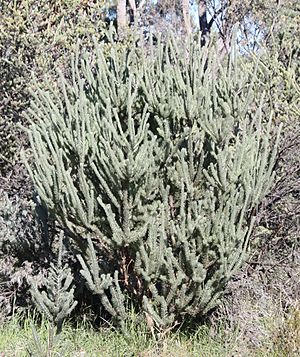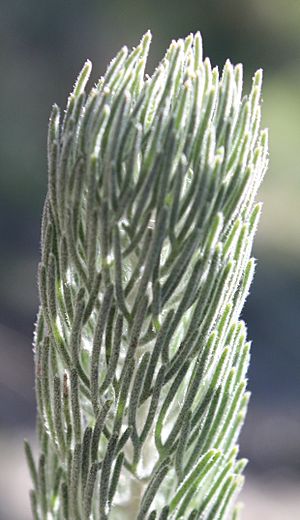Common woollybush facts for kids
The common woollybush (Adenanthos cygnorum) is a tall, fuzzy shrub. It belongs to the Proteaceae plant family. You can find it growing naturally in Western Australia. It's especially common in the southwest part of the state, from Geraldton down to Kojonup. You might often see it along roadsides and in areas where the land has been disturbed, like around Perth.
Quick facts for kids Common woollybush |
|
|---|---|
 |
|
| Scientific classification | |
| Genus: |
Adenanthos
|
| Species: |
cygnorum
|
| Subspecies | |
|
A. cygnorum subsp. cygnorum |
|
What Does it Look Like?
The common woollybush can grow up to three metres (about 10 feet) tall. It has soft, grey-green or grey-blue leaves. These leaves are small and hairy, packed closely together on bendy, hairy stems. The plant feels and looks very woolly, which is how it got its name.
The leaves have tiny parts called nectaries at their tips. These nectaries produce a sweet liquid called nectar. This nectar attracts ants. The ants help spread the plant's seeds. They carry the nectar-filled seeds back to their nests to eat the nectar. This keeps the seeds safe from birds and other animals.
Unlike many other plants in the Proteaceae family, the common woollybush does not have large, bright flowers. Its flowers are small, dull, and often hidden among the leaves.
Sometimes, moths lay their eggs inside the plant's stems. Then, female wasps use these moth larvae to lay their own eggs.
How is it Named?
The common woollybush is a type of Adenanthos plant. Most Adenanthos species are found only in the Southwest botanical province of Australia.
The first time Adenanthos cygnorum was collected was in 1818. An English botanist named Allan Cunningham found it near the Swan River in Western Australia. The name cygnorum comes from the Latin word cygnus, which means 'swan'. This name refers to where the plant was first found.
There are two main types, or subspecies, of common woollybush:
- Adenanthos cygnorum subsp. cygnorum
- Adenanthos cygnorum subsp. chamaephyton
The second type, Adenanthos cygnorum subsp. chamaephyton, grows low to the ground like a mat. It is quite rare and not much is known about it. Some groups of these plants are at risk, but they are not currently considered endangered.
Where Does it Live and What Affects It?
The brown honeyeater (Lichmera indistincta) is a bird that has been seen feeding on the flowers of the common woollybush. These birds help to pollinate the plant.
The common woollybush is very sensitive to a plant disease called Phytophthora cinnamomi dieback. This disease can cause the plant to wither and die.
See also
 In Spanish: Adenanthos cygnorum para niños
In Spanish: Adenanthos cygnorum para niños


